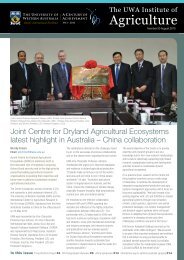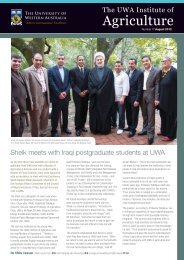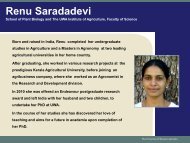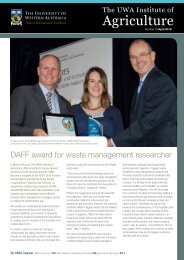Presentation: Improving salt tolerance of wheat - The UWA Institute ...
Presentation: Improving salt tolerance of wheat - The UWA Institute ...
Presentation: Improving salt tolerance of wheat - The UWA Institute ...
- No tags were found...
Create successful ePaper yourself
Turn your PDF publications into a flip-book with our unique Google optimized e-Paper software.
IMPROVING SALTTOLERANCE OF WHEATRana MunnsCSIRO Plant Industry, andUniversity <strong>of</strong> Western Australia
<strong>The</strong> food demand gap
Environmental IssuesDroughtLoss <strong>of</strong> biodiversitySalinityBiotic stress
Outline <strong>of</strong> talk• Two types <strong>of</strong> dryland salinity in Australia• How native plants evolved to deal with it• How agriculture deals with it, through plantphysiology, genetics and plant breeding
Origin <strong>of</strong> salinity in Australia• Salt in the Australian landscape has mainly come fromthe sea via wind and rain• <strong>The</strong> concentration at the soil surface depends on therainfall and the type <strong>of</strong> vegetation• In higher rainfall areas (300-500 mm) rising water tablesbrings <strong>salt</strong> to the surface <strong>of</strong> cleared land• In low rainfall areas (250 mm and below), the <strong>salt</strong> staysbelow the soil surface, in the root zone
Areas in which there is land atrisk <strong>of</strong> rising water tables(National Audit 2001)CairnsBrisbanePerthAdelaideSydneyMelbourneHobart
WAWhere rainfall exceeds crop use,and unused water escapes belowthe roots, rising water tables canbring the <strong>salt</strong> to the surfaceWANSWSecondary salinity – seepage or “rising watertable” salinity
Two types <strong>of</strong>dryland salinitySalt rises to the surface“seepage salinity”Salt stays below groundsurface sodicity is indicative <strong>of</strong>subsoil or “transient salinity”P. RengasamyAust J Exp Ag 2002;
Low rainfall areas (
Natural subsoil salinity(<strong>salt</strong> is low at the soil surface, and increases with depth)0 50 100 150 mM NaCl (1/3 seawater)Metres belowsoil surface2soil surface46810Based on YP Dang et al. Aust J Soil Res, (2010) Fig 5.
Rainfall in the south-west <strong>of</strong> WAIndian Ocean Climate Initiative Note No 5 (2005)
Indian Ocean Climate Initiative Note No 5 (2005)
Growth response <strong>of</strong> the world’s two staple crops,and the most useful two halophytes120Shoot DW (% control)10080604020rice<strong>wheat</strong>seawatertall <strong>wheat</strong>grass<strong>salt</strong>bush00 200 400 600 800NaCl (mM)
Old man <strong>salt</strong>bushAtriplex nummulariawith inter-rows <strong>of</strong> tall<strong>wheat</strong>grassEd Barrett-Lennard,DAFWA & <strong>UWA</strong>
Farmers say:“Every <strong>salt</strong>bush plant paid foritself in the 2001/02 drought… “Photo. M. Lloyd“ …and again infloods <strong>of</strong> Jan 2006”Ed Barrett-Lennard, DAFWA & <strong>UWA</strong>Photo M. Lloyd
What makes <strong>salt</strong>bush so tolerant?1. Tight control <strong>of</strong> <strong>salt</strong> entering plant with water –over 95% is excluded from leaves2. Cells in leaves can tolerate extremely highconcentrations – well over seawater concentrations3. Bladders on leaves excrete excess <strong>salt</strong>4. Seeds do not germinate until after heavy rain5. Some species are annuals, some perennials6. Fast growth
Salt bladderson surface <strong>of</strong><strong>salt</strong>bush leaves(scanning electron micrographby Richard Storey)
Diversity in <strong>salt</strong> <strong>tolerance</strong> in the <strong>wheat</strong>/barley familyat the salinities found in the Australian <strong>wheat</strong> belt100Shoot growth (% control)80604020sea barleygrasstall <strong>wheat</strong>grassbarleydurum <strong>wheat</strong><strong>wheat</strong>00 50 100 150 200 250 300NaCl (mM)Colmer, Munns and Flowers, Aust J Exp Agric (2005)
Durum <strong>wheat</strong> is used for pasta and couscous
Total dry weight (g)Osmotic versus <strong>salt</strong>-specific effect <strong>of</strong>soil salinity on growth54ControlOsmotic effect3210bread <strong>wheat</strong>Saltdurum <strong>wheat</strong>0 10 20 30 40SaltspecificeffectTime after NaCl added (d)Munns et al. Aust J Plant Phys (1996)Munns, Schachtman, Condon, AJPP 1995
Two main mechanisms <strong>of</strong> <strong>salt</strong> <strong>tolerance</strong><strong>The</strong> two ways <strong>of</strong> avoiding <strong>salt</strong> toxicitySalt exclusionTissue <strong>tolerance</strong>NaClNaClLeaf cell -<strong>salt</strong> stored safelyin vacuoleRoot cell - <strong>salt</strong> excluded
Control points for Na + transport in plants3.3. Removal <strong>of</strong> Na + into sheath2.2. Loading Na + into the xylem1.1. Na + uptake from soil
Selecting for natural variation in <strong>salt</strong> <strong>tolerance</strong>
Accumulation <strong>of</strong> Na + in leaves1400Na + concentration (mol gDW -1 )120010008006004002000High Na + Tamaroi Wollaroi Low Na + Janzdurum (durum) (durum) durum (bread)landracelandrace
Physiological mechanism <strong>of</strong> Nax1 and Nax2Physiological mechanism <strong>of</strong> Nax1 and Nax2Nax1Nax1: Unloads Na +from the xylem inroots and leaf base(HKT1;4)Nax2Nax2: Unloads Na +from the xylem in roots(HKT1;5)
Backcrossing into Australian durum<strong>wheat</strong> cultivarUnique durumderivative Line 149(a result <strong>of</strong> a previouscross between Triticummonococcum and adurum rust-sensitivecultivar for the purpose<strong>of</strong> rust breeding)Richard James,CSIRO Plant Industrydurum cultivarTamaroi
Salt-affected field in northern NSWECa(mS m -1 )500450400350300250200150N1 kmAndrew Smart (PCT, Narrabri) - 2008Munns et al, Nature Biotechnology, 2012
Using an EM meter to measure soil <strong>salt</strong>Richard James, CSIRORay Hare, durum breeder,NSW DPI
Chloride concentration in soil solution (mM)Sodium and chloride increase withdepth, to half-strength seawater3002502001501005000 - 2020 - 40Soil depth (cm)40 - 6060 - 8080 - 90BLOCK 2BLOCK 3BLOCK 1
Taking leaf samples for Na analysis
Relationship between soil salinity and yield <strong>of</strong>durum <strong>wheat</strong> cultivar Tamaroi with Nax2 gene3.53.0Block 1Block 2Block 3Grain yield (t/ha)2.52.01.5+ Nax21.0- Nax20.5260 280 300 320 340 360 380 400 420 440 460 480ECa (DS/m)
Yield data from different sites withdifferent salinity130Ashley2009(Block 1) (Block 2) (Block 3)5004Yuluma2009Ashley20081205042Nax2 linesYield (% Tamaroi)1101009080High salinity(ECa) 400 336 309 236200701.0 1.5 2.0 2.5 3.0 3.5Site mean yield (t/ha)Moderate to lowsalinityJames et al. Funct. Plant Biol (2012)
120Benefit <strong>of</strong> Nax2 on grain yieldin selected trial sites*Grain yield (% Tamaroi)11010090800Field 1 Block 1 Block 2 Block 3Moree 2008Field 2, Moree 2009Munns et al, Nature Biotechnology (2012)
Crossing Nax genes from durum intobread <strong>wheat</strong>Carol Blake (CSIRO Plant Industry) makingcrosses between durum <strong>wheat</strong> (male) containingNax genes and bread <strong>wheat</strong> (female) parents
SUMMARYSalt underlies all Australian soilsWhere rainfall is low, crops use all the water so <strong>salt</strong>concentrations increase in the subsoil. Crops mustbe <strong>salt</strong> tolerantWhere rainfall is high, water escapes below theroots and rising watertables bring <strong>salt</strong> to thesurface. Plants employed to lower watertables mustbe very <strong>salt</strong> tolerantGenetic improvement in <strong>salt</strong> <strong>tolerance</strong> will befastest when laboratory scientists work togetherwith agronomists and breeders
AcknowledgementsCSIRO Plant IndustryRichard JamesCarol BlakeCaitlin ByrtShaobai HuangEvans LagudahWolfgang SpielmeyerMark Tester, ACPFGMatthew Gilliham, Uni AdelaideCollaborating Breeders:Ray Hare, NSW DPITony Rathjen, Uni AdelaideAndrew and Jodie Crowe(growers, northern NSW)
















